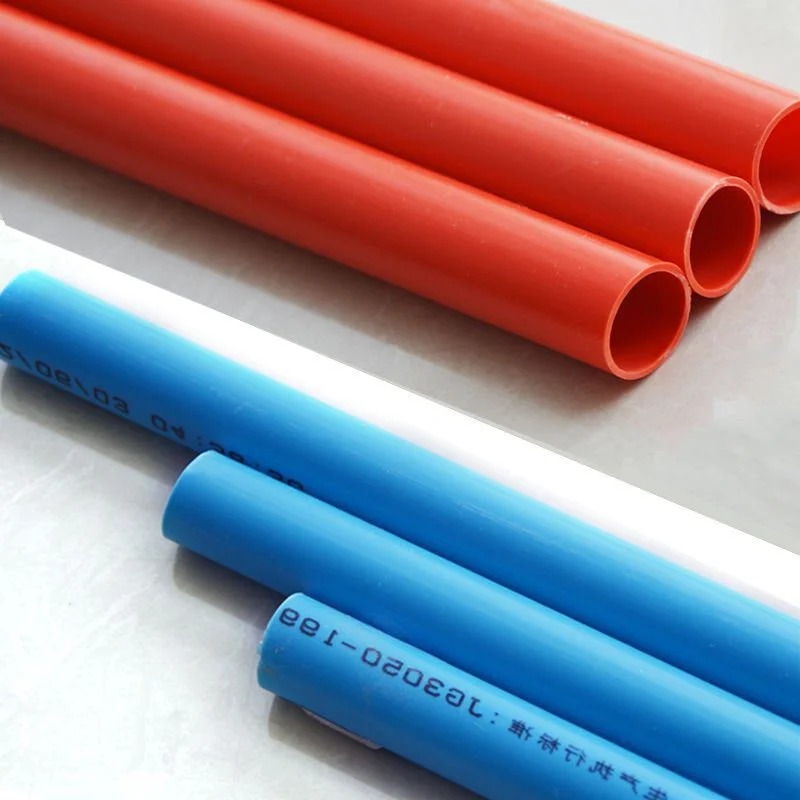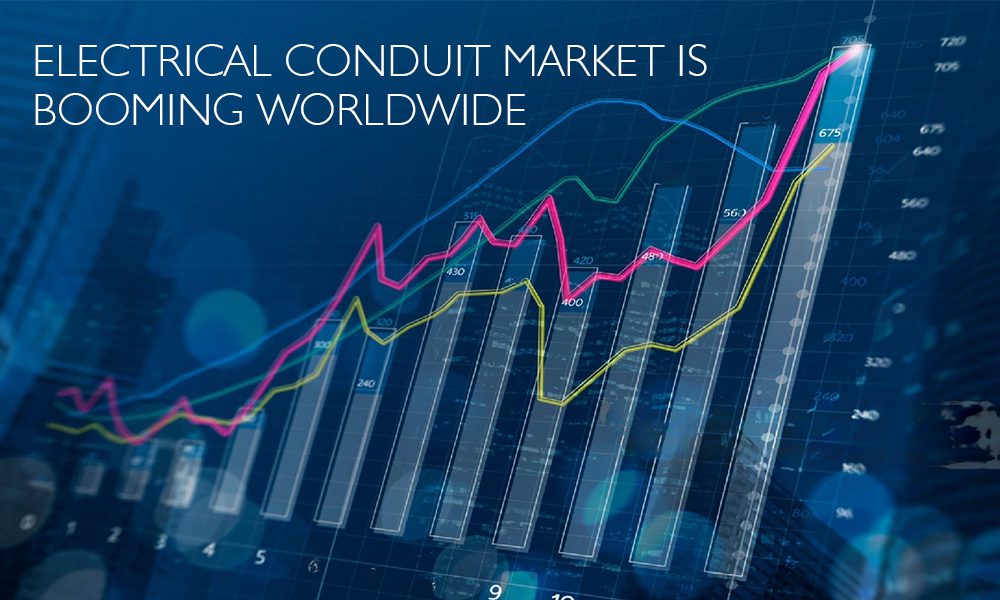Conduíte elétrico é uma estrutura tubular feita de materiais como metal, plástico ou PVC, projetada para proteger cabos e fiação elétrica. Ele desempenha um papel crucial em garantir um gerenciamento de cabos seguro e organizado, protegendo os cabos de fatores ambientais, danos físicos e interferência eletromagnética. As aplicações de conduíte elétrico abrangem vários setores, incluindo setores residenciais, comerciais e industriais.
Demanda crescente e aplicações:
Na era digital de hoje, a demanda por soluções de gerenciamento de cabos eficientes e confiáveis aumentou. A crescente dependência de tecnologias como transmissão de dados, telecomunicações e automação industrial levou a sistemas de cabeamento intrincados que exigem organização e proteção adequadas, a necessidade de conduítes elétricos seguros e confiáveis se tornou mais crucial do que nunca. Os conduítes elétricos servem como um caminho de proteção para cabos e fios elétricos, garantindo sua segurança e o bom funcionamento de redes de distribuição de energia, data centers, telecomunicações e instalações de energia renovável. Com suas diversas aplicações e demanda crescente, o mercado de conduítes elétricos está experimentando um crescimento significativo.
Tendências da indústria e impulsionadores do crescimento:
O mercado de conduítes elétricos está testemunhando um crescimento significativo devido a vários fatores.
- Demanda crescente por desenvolvimento de infraestrutura: A demanda global por desenvolvimento de infraestrutura, incluindo projetos residenciais, comerciais e industriais, está impulsionando o crescimento do mercado de conduítes elétricos. À medida que novos edifícios, fábricas e projetos de infraestrutura são construídos, a necessidade de sistemas de conduítes elétricos seguros e confiáveis para proteger a fiação e os cabos se torna essencial.
- Setor de Energia Renovável em Crescimento: A crescente adoção de fontes de energia renováveis, como energia solar e eólica, está contribuindo para o crescimento do mercado de conduítes elétricos. Os sistemas de conduítes são vitais para a instalação de fiação em painéis solares, turbinas eólicas e outras infraestruturas de energia renovável, fornecendo proteção e garantindo transmissão eficiente de energia.
- Aumento da Construção de Data Centers: A proliferação de tecnologias digitais e a demanda por armazenamento e processamento de dados levaram à construção de vários data centers no mundo todo. Esses data centers exigem sistemas de conduítes elétricos confiáveis para suportar a intrincada rede de cabos e fiação, garantindo fornecimento de energia e transmissão de dados ininterruptos.
- Ênfase em Segurança e Conformidade com o Código: Os regulamentos de segurança e os códigos elétricos desempenham um papel crucial no mercado de conduítes elétricos. Governos e órgãos da indústria estão continuamente atualizando e aplicando padrões de segurança, impulsionando a demanda por sistemas de conduítes que atendam a esses requisitos. Os fabricantes de conduítes estão se concentrando na produção de produtos que oferecem recursos de segurança aprimorados, incluindo resistência ao fogo, isolamento e proteção contra riscos elétricos.
- Avanços tecnológicos em materiais de conduítes: O desenvolvimento de novos materiais e técnicas de fabricação está revolucionando a indústria de conduítes elétricos. Materiais avançados, como polietileno de alta densidade (PEAD), fibra de vidro e aço inoxidável, oferecem maior durabilidade, resistência à corrosão e flexibilidade. Esses avanços fornecem aos consumidores uma gama mais ampla de opções e contribuem para o crescimento do mercado.
- Foco crescente em soluções sustentáveis e energeticamente eficientes: A ênfase crescente em sustentabilidade e eficiência energética está influenciando o mercado de conduítes elétricos. Os fabricantes de conduítes estão incorporando práticas ecologicamente corretas em seus processos de produção e oferecendo sistemas de conduítes que dão suporte a iniciativas de economia de energia.
- Adoção de tecnologias de edifícios inteligentes: O surgimento de tecnologias de edifícios inteligentes, incluindo dispositivos IoT e sistemas de automação, requer infraestrutura de conduíte elétrico sofisticada. Edifícios inteligentes dependem de sistemas de conduíte para gerenciar e organizar a extensa rede de cabos e fiação necessária para conectividade e troca de dados sem interrupções.
De acordo com um relatório da Allied Market Research, o aumento na demanda por sistemas de fiação seguros, juntamente com o aumento das atividades de construção comercial, está impulsionando o crescimento do mercado de conduítes a cabo. O mercado de conduítes a cabo foi avaliado em $4,4 bilhões em 2022, e está projetado para atingir $9,3 bilhões até 2032, exibindo uma taxa de crescimento anual composta (CAGR) de 8,2% de 2023 a 2032. Esses números destacam o robusto potencial de crescimento e a crescente importância da indústria de conduítes a cabo.
Atualmente, os tipos mais amplamente utilizados de conduítes elétricos são conduítes de PVC, conduítes de metal (como aço galvanizado ou alumínio) e conduítes flexíveis. Esses tipos atendem a diferentes aplicações e oferecem benefícios exclusivos.
A escolha do conduíte depende de fatores como aplicação, ambiente e requisitos específicos do código elétrico. Aqui estão alguns dos tipos mais amplamente usados:
Eletroduto metálico rígido (RMC): RMC é um conduíte de alta resistência feito de aço galvanizado ou aço inoxidável. Ele fornece excelente proteção mecânica e é frequentemente usado em aplicações industriais e comerciais onde durabilidade e proteção de alto nível são necessárias.
Eletroduto metálico intermediário (IMC): IMC é similar ao RMC, mas é mais leve e mais econômico. Também é feito de aço galvanizado e fornece proteção mecânica moderada. IMC é comumente usado em aplicações comerciais e industriais.
Tubulação metálica elétrica (EMT): EMT é um conduíte leve feito de aço galvanizado ou alumínio. É fácil de trabalhar e comumente usado em aplicações residenciais e comerciais. EMT fornece boa proteção contra danos físicos, mas pode não oferecer o mesmo nível de proteção que RMC ou IMC em ambientes severos.
Conduíte de PVC: O conduíte de PVC (cloreto de polivinila) é uma opção não metálica feita de material de PVC rígido. É leve, fácil de instalar e resistente à corrosão e umidade. O conduíte de PVC é comumente usado em aplicações residenciais e comerciais, particularmente onde conduíte não metálico é necessário.
Eletroduto metálico flexível (FMC): FMC, também conhecido como “Greenfield,” é um conduíte flexível feito de tiras de metal enroladas em espiral, tipicamente aço galvanizado ou alumínio. Ele oferece flexibilidade e facilidade de instalação, tornando-o adequado para aplicações onde a fiação precisa ser roteada em torno de obstáculos ou requer mudanças frequentes.
Eletroduto metálico flexível estanque (LFMC): LFMC é similar ao FMC, mas tem um revestimento adicional à prova de líquidos, geralmente feito de PVC ou borracha termoplástica. Ele fornece proteção contra umidade, óleos e outros líquidos e é comumente usado em locais externos ou úmidos.
Conduíte não metálico (NM ou Romex): O conduíte NM, também conhecido como Romex, é um tipo de cabo com bainha não metálica que inclui vários condutores isolados e um fio terra. É comumente usado em fiação residencial para tomadas, interruptores e luminárias. Embora não seja um conduíte no sentido tradicional, ele serve a um propósito semelhante de proteger e organizar a fiação elétrica.
Ctube: Inovando para a Indústria de Conduítes Elétricos
Como um fabricante personalizado focado em pesquisa e desenvolvimento de conduítes elétricos, a Ctube está comprometida em impulsionar a inovação e criar novas oportunidades no mercado. Ao se manter à frente das tendências do setor, a Ctube visa fornecer soluções de ponta que atendam às necessidades em evolução do setor de gerenciamento de cabos. Com um portfólio competitivo de produtos de PVC rígido e conduítes flexíveis, a Ctube surgiu gradualmente no setor elétrico e se tornou uma das marcas competitivas, mais e mais pessoas reconheceram a Ctube, e os conduítes elétricos da marca Ctube têm sido usados em mais e mais projetos de grande escala.
Compromisso da Ctube com a sustentabilidade:
A Ctube reconhece a importância da sustentabilidade ambiental e se dedica a desenvolver soluções de conduítes ecologicamente corretas. Investimos ativamente em pesquisa e desenvolvimento para explorar materiais alternativos e processos de fabricação que minimizem o impacto ambiental. Ao oferecer opções de conduítes sustentáveis, a Ctube visa dar suporte à crescente demanda por soluções de gerenciamento de cabos ambientalmente responsáveis.
A indústria de conduítes elétricos continua a evoluir e se adaptar para atender às necessidades em mudança do mercado. Com foco em avanços tecnológicos, sustentabilidade e inovação de produtos, a indústria está pronta para um crescimento maior, à medida que a demanda por soluções eficientes de gerenciamento de cabos continua a aumentar.



